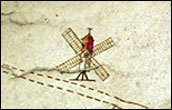Passenham Mills
 |
In 1086 the water mill belonged to the Royal Estate
A new windmill was first mentioned in 1557 |
 |
| There is mention in the Domesday survey of a mill at Passenham which belonged to the Royal Estate, it was clearly a primitive water mill since the more sophisticated types had not yet been introduced, it appears to have been in use until 1415 until it was superceded by a new windmill first mentioned in 1557. The exact location is not known although there was a Windmill Field mentioned in 1659. A Glebe Terrier of the mid 17th century indicates the return to use of the water mill. A survey of the Maynard estate at the end of the 18th century shows a rent from the watermill but no mention of the windmill. When Queen Mary attempted to re-establish the Hospitallers in 1558, the order’s possessions in Passenham included the water-mill, then in the tenure of Henry Turvey. In 1509 Richard Awchin was known as the miller at Passenham, later in 1556 to Robert Fowkes but was not included in the sale of the Manor to Banastre in 1623 but appears to have been granted to him in fee at a later date, for in 1650 the fee farm rent of 26/8d was prepared for sale, when the mill was occupied by Roger Turvey. Others who were known to be occupying the mill were Thomas Buckingham from at least the 1790s The mill itself then had two wheels driving three pairs of stones. George Gates was the tenant from the 1830s until his death in 1860 when he was succeeded by William Webb. James Rogers was the miller from around 1885 until about 1910, he was followed by John N Frost of Manor Farm, who was still operating the mill in 1914. In 1918 it was offered for sale in working order, with two wheels driving four pairs of stones, together with a house and 22 a. of land. The mill ceased to work shortly after sale and was later converted to residential use. The present day Mill cottages are a relatively recent conversion of the old mill which ceased to operate as around 1920. |
||||||
|
||||||
|
|
||||||
|
Views of Passenham Mill from 1907 & the floods of 1908
|
